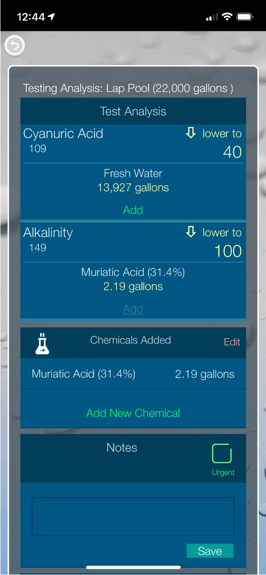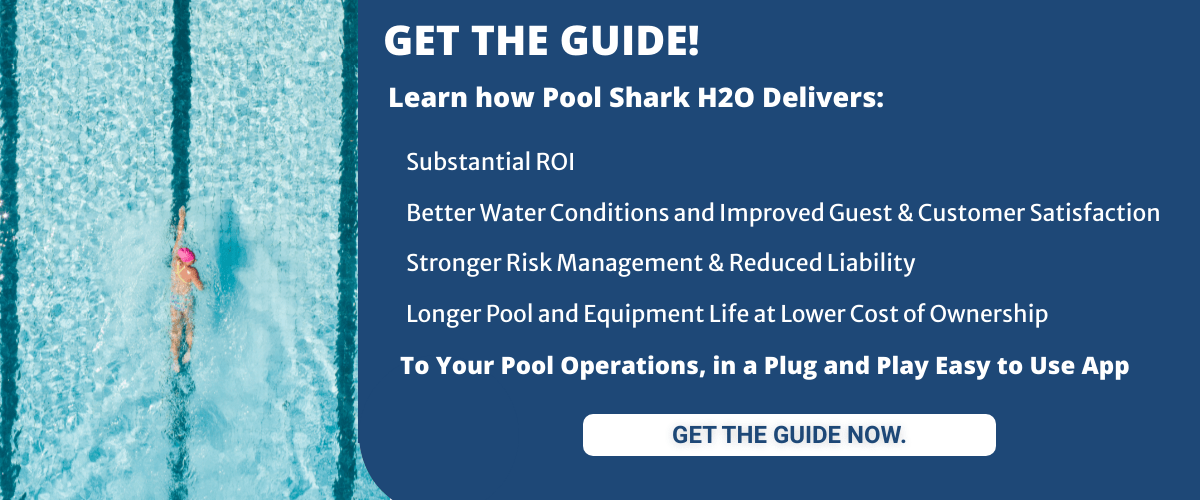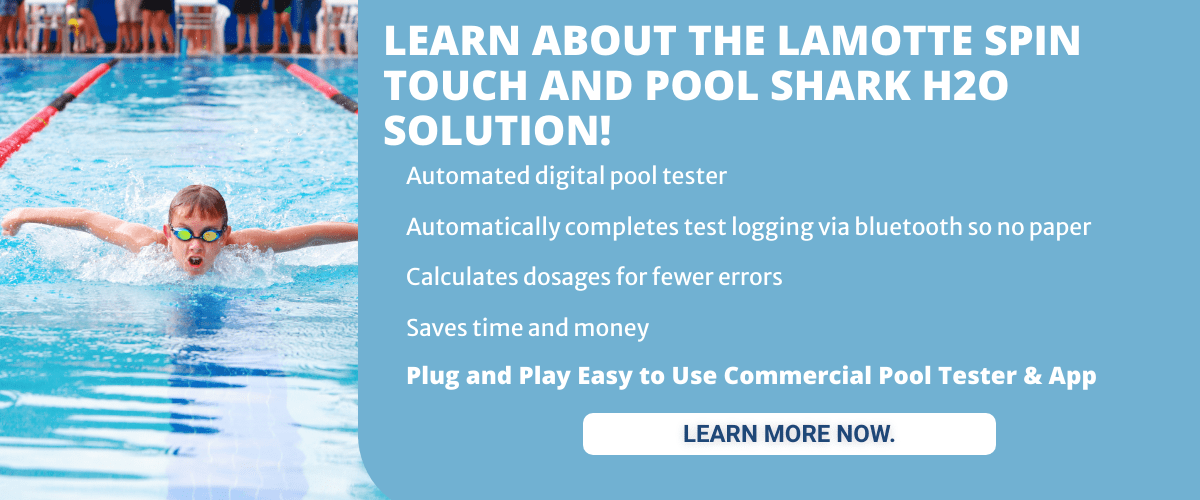When performing chemical tests of pool water, one of the most important chemical levels to measure and make note of is chlorine. Chlorine is put in commercial or public pool water for the purpose of sanitation and is a vital chemical when it comes to keeping pools clean. Without proper chlorine levels in the pool water, pools can offer a bad or even unsafe user experience.
Why This is Important to Commercial and Public Pools
For example, if too little chlorine is in the pool, the water can turn cloudy and/or green, and illnesses can potentially be allowed to spread. On the other hand, too much chlorine can potentially irritate swimmers’ lungs, cause skin and eye damage, and provoke asthma. For these reasons, it’s best to keep chlorine levels in the required ranges.
Types of Chlorine to be Measured in Public or Commercial Pools
Unfortunately, measuring chlorine to monitor its levels isn’t as simple as it sounds. Many inexpensive water testing kits exist that only test for what is called “total chlorine”. This isn’t always helpful and won’t give you an accurate representation of the cleaning capabilities of the chlorine in your water. To get a more accurate idea of how much chlorine is actually cleaning your pool, first, you must understand the difference between different types of chlorine.
Free Chlorine
Free chlorine is chlorine that is “free” to help keep the pool clear and cleaned. It is chlorine that hasn’t reacted with any contaminants, bacteria and/or microorganisms in the pool yet, and is therefore available to do so, cleaning the pool as it does. Free chlorine levels should measure between 2 and 4 ppm in the pool.
Combined Chlorine
Combined chlorine is chlorine that has “combined” or reacted with a contaminant to a pool, which it is now bound to. Usually, this is the type of chlorine you can smell near a pool. When combined chlorine levels exceed 0.44 ppm, the CDC recommends you shock your pool to free up chlorine by converting combined chlorine back to free chlorine. Finding that there is combined chlorine in the water is an indication that free chlorine has done its job by attaching itself to the organic material or contaminant in the water and disinfecting it. Pool owners and operators should try to keep combined chlorine levels low, as this will ensure the chlorine in the pool is working to sanitize the water and will provide better air quality around the pool.
Total Chlorine
Total chlorine is the sum of the free and combined chlorine in the pool:
FC + CC = TC or Free Chlorine + Combined Chlorine = Total Chlorine
It is essential that public and commercial pool operators understand this formula.
Some commercial pool test kits, mostly inexpensive ones, only test for total chlorine, but this isn’t very useful, as total chlorine doesn’t indicate how much of the chlorine is free and able to perform cleaning duties. In theory, if the water is kept very clean, total chlorine tests can be used to test for free chlorine. This is unrealistic for commercial and public pool owners and operators, however, because any frequent use of the pool will release contaminants into the water that must be cleaned.
Additionally, outdoor pools are subject to contaminants like rain, leaves, pollen, and others, which can also alter pool chemistry and may react with free chlorine to produce combined chlorine. As soon as there is any combined chlorine in the water, measuring total chlorine alone is useless.
Shocking the Pool
As mentioned before, when the combined chlorine level gets high, CPOs must shock the pool to free up chlorine. To shock the pool, they must bring the chlorine to its breaking point, otherwise, it may just increase the chlorine in the pool and not break down the combined chlorine, which is a waste of expensive chemicals. The breaking point of chlorine is ten times the combined chlorine level, so if the free chlorine level is at 1 ppm, CPOs must add 9 ppm to bring it up to a total of 10 ppm. If too much chlorine is added, chlorine levels may exceed what is allowed by the local department of health, requiring the CPO to add another chemical to lower the chlorine level. This can be expensive and time-consuming, and is, therefore, something to avoid. The best way to do so is to keep a close eye on combined chlorine levels and ensure that they stay low.
Different Chlorine Solutions
When adding chlorine to a pool, whether it is a home pool or public commercial pool, there are several options for chlorine addition products. Typically, chlorine products come in a liquid, powder or tablet form. The choice between different chlorine products can be about costs and benefits, but also has a lot to do with personal preference.
Chlorine Gas
Chlorine gas is the most potent form of chlorine product, being 100% chlorine. It is usually considered overkill for residential use but is still used by some maintenance professionals due to its efficiency in both time and cost, and it raises chlorine levels efficiently compared to chlorine acid liquid. Unfortunately, chlorine gas can be incredibly dangerous if not handled correctly and is illegal to use in many states due to the high risk of casualties if a leak occurs.
Chlorine Tablets (Trichlor)
Trichlor tablets are quite potent with a 90% chlorine content and are therefore highly efficient. Trichlor is a common sanitizer in private and residential pools as it is cost-effective for time and money (although its price may soon rise, we’ll revisit that later), and is dispersed passively, making its addition to the pool fairly easy. This doesn’t mean pool owners can simply toss trichlor tablets in the pool, however, as it is advisable to use an automatic chlorinator or chlorine dispenser. Trichlor also raises cyanuric acid levels and has a low pH of around 3, which can require a pH increaser to keep water between the required range of 7.2 and 7.8 pH. Worst case scenario, high cyanuric acid levels can require draining water to bring the level down, which can be an expensive process.
Liquid Bleach (Sodium Hypochlorite)
Liquid bleach is a very common option used by pool professionals, as it is the least expensive form of chlorine sanitizer, it is time effective as it can be added in bulk and it won’t increase cyanuric acid levels in the water. It is also convenient if a pool is using an automated controller to help regulate chemical levels, as it can be easily added by an automated controller. Liquid bleach does have some drawbacks, particularly for private residential pools. It has a pH of 13 or higher, requiring users to add acid to counter the pH effects, and can be highly corrosive to pool surfaces if not added correctly. Both of these issues can reduce the cost-effectiveness of liquid bleach, leading to the long-term costs outweighing the short-term savings. Special storage facilities for liquid bleach may also be required, leading to potential up-front expense.
Cal-Hypo (Calcium Hypochlorite)
Cal-hypo is one of the most popular powder sanitizers for private pool owners, as it is one of the most effective chlorine sanitizers other than liquid bleach. Cal-hypo products typically have a chlorine concentration of 65-75% and have a pH of 12, so the acid will need to be added to maintain proper pH levels. If not added properly, it is possible for cal-hypo to raise the calcium hardness levels of the pool, and if the water stays too hard for too long, it can cause corrosion of the pool surface.
Dichlor
Dichlor has a chlorine concentration of 60-65%, making it comparable to cal-hypo, but is also more expensive than cal-hypo. It is easy to spread around the pool as a powder sanitizer and is stable enough to be used both as chlorine sanitizer and shock if necessary. With a pH of 7, only a small amount of pH increaser may be required, but like trichlor, it can raise cyanuric acid levels.
Chlorine Shortage
Somewhat alarmingly, there is recent concern among both pool and chlorine industry professionals that there will be a chlorine shortage in 2021. Unfortunately, this is the result of both increased demand and decreased supply for chlorine products. Demand has increased over previous years due to the boom in backyard pool construction in the summer of 2020. Due to pandemic restrictions in 2020, many families were forced to stay home far longer and more frequently than they usually would during the summer, and many saw a pool as a good investment. Particularly due to kids being out of in-person school even in the spring and early fall, pools are a great way to keep them entertained and can be a great “staycation” amenity. For these reasons, demand for backyard pools skyrocketed last year, and now far more private pool owners need chlorine products to keep their pools clean.
Decreased supply will also be a serious issue in the chlorine industry in the coming year. In August of 2020, Hurricane Laura made landfall in the state of Louisiana and wreaked havoc on many coastal communities in the area. During the storm, there was severe damage to KIK Custom Products, a large BioLab chemical facility that was responsible for producing many of their Trichlore and disodium isocyanurate products. The damage led to a fire at the plant that lasted for three days, which has likely ruined significant amounts of the 835 tons of inventory at the facility, although it is still unclear exactly how much of it was damaged or can be salvaged. Biolab is an industry leader in the production of Trichlore products, and this facility produced about one-third of the Trichlore used in the United States, so losing this production facility will deal a massive blow to chlorine product availability this year.
With a global health crisis forcing pool owners to keep their facilities as clean as possible, pool owners and operators need these chemicals now more than ever. Due to the higher demand for chlorine products and the lower inventory than normal, pool owners and operators must stock up on chlorine products if at all possible. Not only will the stock of these products sell out quickly, but as chlorine products get more scarce, price increases will inevitably cause further financial strain on pool owners. Thankfully, chlorine products don’t expire very quickly, so buying them in bulk ahead of time for the majority or entirety of the upcoming season isn’t an issue. It is also very important to note that if pool owners purchase multiple forms or types of chlorine products, they must not be mixed. Adding different types of chlorine together can cause a potentially deadly chemical reaction and explosion.
Making Commercial and Public Pool Chlorine Management Easier
This comprehensive information about chlorine can be a lot to take in and process as a pool owner. Keeping an eye on different types of chlorine like free, combined, and total can be stressful, ensuring that free chlorine levels don’t get too low, that combined chlorine doesn’t get too high, and that you’re using the right type of tester to give an accurate indication of chlorine levels can be a lot to think about. What’s most important to remember is that keeping free chlorine at the right levels can make life a lot easier.
Choosing which chlorine addition solution works best for you can also be a daunting task. Trying to find the right balance between effectiveness, convenience, availability, and price can take a lot of research, but once again, keeping free chlorine at the right levels can reduce the frequency with which you need to add chlorine or shock your pool, saving time and money.
Chlorine shortages this year will make it difficult to acquire more chlorine as the year goes on. Using chlorine as efficiently and infrequently as possible is vital more so than ever, and as mentioned above, keeping free chlorine at the right levels can reduce the frequency with which chlorine must be added, and can make life far easier by saving time and money. But how can pool owners keep free chlorine levels where they’re supposed to be?
Pool owners and managers can make chlorine monitoring and addition far easier using the Pool Shark H2O app. Pool Shark H2O takes the data from pool water chemical tests and stores it in a secure cloud database pool log. Using this data, it performs calculations to determine how much of each chemical (including chlorine) must be added to perform corrections and keep chemical levels in the required ranges. If chlorine levels get too low, Pool Shark H2O can give users the exact amount to add, regardless of what type of chlorine they’re using, and can advise them on making subsequent corrections to pH as well.

The Pool Shark H2O App Makes Commercial and Public Pool Testing and Maintenance easy, even doing the complex calculations required of CPOs easy.
With Pool Shark H2O’s close monitoring of chemical levels including the three types of chlorine, pool operators have a better idea of how well they’re maintaining the chemical balance of their pool. This awareness coupled with Pool Shark H2O giving the exact amount of each chemical to add can help CPOs keep their pools in better chemical balance, and keep them far cleaner, wasting fewer chemicals and saving money. If the predicted chlorine shortages occur later this year, saving chemicals and money will be vital.
More Commercial Pool Chemistry Resources
Chlorine Shock vs Non-Chlorine Swimming Pool Shock
Why Being Able to Calculate the Volume of a Commercial or Public Swimming Pool is Important
Cyanuric Acid Levels in Swimming Pools
Ideal Alkalinity in Commercial Pools
Managing pH and Alkalinity in Pools
Commercial Pool Chlorine Management
Cyanuric Acid in Your Pool Too High? How to Remove Cyanuric Acid (Lower Pool Stabilizer)
Lowering Alkalinity in Swimming Pools
Reasons Your Public or Commercial Pool Water Could Be Cloudy
Muriatic Acid in Swimming Pools
How to Lower pH in Pools, Water Parks and Water Features
Does Chlorine Kill Poop in a Swimming Pool?
Total Dissolved Solids: When Should I Drain My Pool?
Why Pool Chemical Storage Cabinets are Important for Commercial Pools
Storing Pool Chemicals: What Commercial Pool Operators Need to Know




